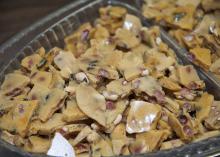Information Possibly Outdated
The information presented on this page was originally released on December 5, 2014. It may not be outdated, but please search our site for more current information. If you plan to quote or reference this information in a publication, please check with the Extension specialist or author before proceeding.
Insects: Coming soon to a dinner table near you
MISSISSIPPI STATE -- The peanut brittle at John and Peggy Guyton’s house looks like it might be made from a special family recipe, but they are not keeping their unique ingredient a secret: insects.
In fact, the Guytons used black soldier fly larvae to provide additional protein to peanut brittle whipped up in the microwave in a matter of minutes. Peggy also bakes banana nut bread with crickets and has several recipes featuring mealworms.
John Guyton, an entomologist with the Mississippi State University Extension Service, said he first began cooking insects for the annual MSU Bug Camp 16 years ago, when he and a colleague served “chocolate chirp cookies.”
“Many insects are tasty, versatile and can easily be added to a variety of recipes,” John Guyton said. “You can grind toasted insects in a coffee grinder and add 1 cup of ground insects to 4 cups flour to make bread, pretzels, or other flour-based recipes. Bugs are a great source of protein and Omega-3 fats.”
Guyton said different insects have distinct flavors. For example, he described ants as “acidic in a good way.”
“Some grubs have an almond flavor, and most roasted insects have a somewhat nutty flavor that would be good in a roasted cereal snack mix during the holidays,” he said.
While insects have been a staple in the diet of many cultures in Central and South America, Africa and Asia, most Americans and Europeans turn up their noses at the idea. But that negative opinion may be changing as more people realize the need for efficient protein sources and the potential for profit.
Each year, the Guytons prepare a variety of delicacies featuring insects for participants at the MSU International Insect Rearing Workshop to try. A growing number of attendees are interested in rearing insects as food for humans, poultry and fish.
Frank Davis, MSU professor emeritus, is the founder and coordinator of the workshop.
“Growing insects for human consumption is becoming an increasingly popular business as people all over the world realize the benefits of finding diverse protein sources,” Davis said. “At the 2014 workshop, 10 participants were from firms interested in getting involved in raising insects for humans to eat.”
Davis predicted that entrepreneurial spirit and commitment to an international, sustainable intensification of food production will result in more people embracing edible insects.
“I know we’ll never get everyone to adopt a diet based primarily on insects, but with the new projection of 9.5 billion people to feed by 2050, we need to come up with some sustainable, nutritious alternatives,” Davis said. “We need a second green revolution to meet the coming demand, and rearing insects for protein will be part of it.”
Adding insects to the ingredient list is not as simple as walking outside and collecting local specimens.
“You need to purchase insects from a reputable source that is growing them for food, and if they are alive, process them properly,” Guyton said. “There are cookbooks and recipes online, and all kinds of websites. It’s not hard to find information.”
To learn more visit http://www.insectsarefood.com/index.html.



